|
Author
|
Topic: How did they pack the Apollo lunar rover?
|
stsmithva
Member Posts: 2094
From: Fairfax, VA
Registered: Feb 2007
|
 posted 03-03-2007 10:12 AM
posted 03-03-2007 10:12 AM
   
How on earth (well, not really) were the Apollo Lunar Roving Vehicles (LRV, rovers) packed onto the same kind of spacecraft that had flown to the moon without a rover? I am sure that because of space limitations, every cubic centimeter of space was carefully accounted for. Were Apollo 15, 16, and 17 just made much larger somewhere, or did they somehow find more space? Are there good diagrams online showing how the rovers were unpacked? To me, this is like going with a couple of friends on a week-long road trip in a crammed Honda Civic, then going on the same trip again — only this time bringing a motorcycle packed in the back seat. |
Robert Pearlman
Editor Posts: 51889
From: Houston, TX
Registered: Nov 1999
|
 posted 03-03-2007 10:28 AM
posted 03-03-2007 10:28 AM
   
As these photographs show, the LRV folded to fit within Quad 1 of the lunar module: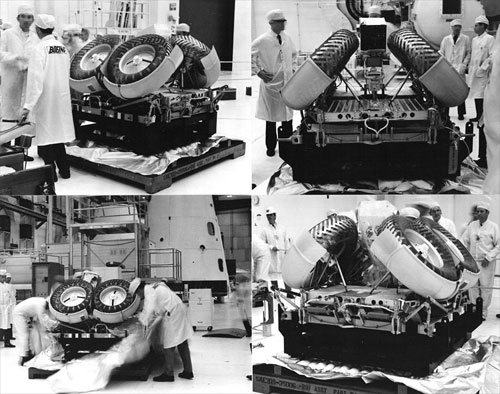 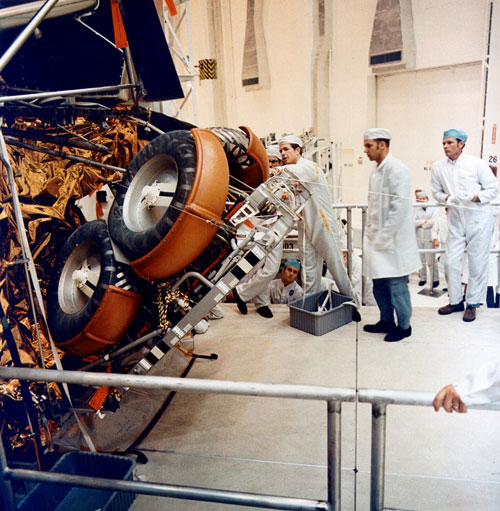
From NASA: For deployment, some thermal blankets needed to be removed from the LM and one of the crew had to climb the ladder to pull a "D-ring", then descend the ladder. Both crew then had to apply a steady pull on deploy cables and tapes until the wheels were on the ground. After it was on the ground, the crew actually picked it up and turned it 90deg. The fenders, seats, seat belts, and console then had to be deployed on it. |
mikej
Member Posts: 483
From: Germantown, WI USA
Registered: Jan 2004
|
 posted 03-03-2007 10:53 AM
posted 03-03-2007 10:53 AM
   
Here's a diagram of the descent stage; the LRV was folded into a wedge shape (best shown in the upper right picture that Robert posted) so it could fit into Quad 1: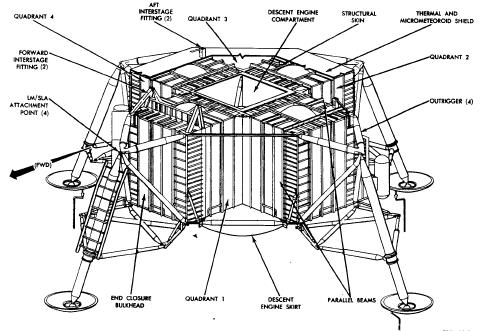 Here's a diagram, taken from the Apollo 15 Press Kit, which shows how it was unfolded: 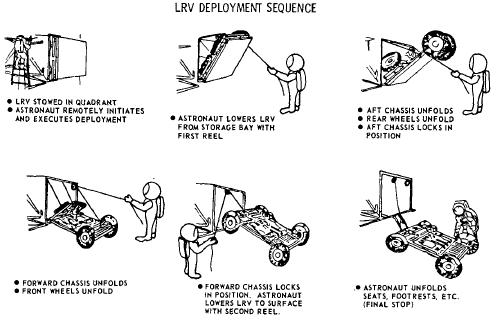 The Apollo Lunar Surface Journal has several video clips of the deployment process. |
stsmithva
Member Posts: 2094
From: Fairfax, VA
Registered: Feb 2007
|
 posted 03-03-2007 04:18 PM
posted 03-03-2007 04:18 PM
   
So just to double-check: the rover was always part of the plan and all the lunar modules were designed to carry them, but since with Apollo 11, 12, 13, and 14 they didn't plan on using them, they either just kept that space empty or carried different equipment there? I would imagine, by the way, that it was quite a challenge to design something here on Earth that would operate in 1/6 Earth gravity. I wonder how they tested the motor and load-bearing parts. |
Spacepsycho
Member Posts: 903
From: Huntington Beach, Calif.
Registered: Aug 2004
|
 posted 03-03-2007 05:05 PM
posted 03-03-2007 05:05 PM
   
The lunar rover was tested using rubber tires on Earth because the titanium mesh tires were designed for the moon's gravity and couldn't support all the weight on Earth. As far as testing motors or any other systems on the LRV, it was no problem on Earth because it was loaded with the equal weight it was designed to carry on the moon. Each wheel has its own electric motor, plus the DC motors had more than enough power to test the LRV on Earth. |
stsmithva
Member Posts: 2094
From: Fairfax, VA
Registered: Feb 2007
|
 posted 03-03-2007 05:20 PM
posted 03-03-2007 05:20 PM
   
Thanks for those details. When you say "it was loaded with the equal weight it was designed to carry on the moon," do you mean they took off 5/6 of what it would carry on the moon?As for the power, I was thinking that the concern would be that it would have too much power while being tested on Earth. That is, they could see how it would accelerate in full gravity, but then they'd have to calculate how much less power it would actually need on the moon, or the astronauts would go flying off the back when they hit the gas in low gravity. Or maybe this is getting into a whole gravity vs. inertia thing that someone who somehow graduated from college without taking a physics course should not try to tackle. |
nasamad
Member Posts: 2192
From: Essex, UK
Registered: Jul 2001
|
 posted 03-03-2007 05:37 PM
posted 03-03-2007 05:37 PM
   
Here's the clips that Mike mentioned. |
mikej
Member Posts: 483
From: Germantown, WI USA
Registered: Jan 2004
|
 posted 03-04-2007 08:38 AM
posted 03-04-2007 08:38 AM
   
quote:
Originally posted by stsmithva:
So just to double-check: the rover was always part of the plan and all the Lunar Modules were designed to carry them...
No the LRV was basically an afterthought; its development wasn't approved until May 1969 (either May 23, according to A Brief History of the Lunar Roving Vehicle or May 27, according to The Apollo Spacecraft - A Chronology). The LRV was actually developed in about 17 months.The earlier lunar modules weren't specifically designed to carry an LRV; they were relatively short-duration stay LMs. All of the early development was focused on "landing a man on the moon and returning him safely to Earth" — long duration stays weren't yet a priority. (Of course, there were many who had dreams or proposals for this sort of thing — both extended stays and some sort of lunar roving vehicle — but such things couldn't be realized until we'd landed a man on the moon — or were pretty confident we could. By early 1968 there were serious discussions of extending lunar stays, but nothing was actually authorized.) A quick search of "Chronology" didn't find anything regarding when the extended-stay missions were authorized, but I did find the following in Where No Man has Gone Before: Equally high on the priority list for exploration missions was extending the time astronauts could stay on the moon. Grumman Aircraft Engineering Company, the lunar module contractor, had made some preliminary studies on modification of the lander for that purpose in 1967. Life-support systems and electrical power were enough for only 36 hours on the surface; longer stays would require hardware changes. Propulsion systems would have to be upgraded to carry the scientific equipment and mobility module to be taken on exploration missions. In March 1969, MSC directed Grumman to define the changes necessary to allow the lunar module to stay three to six days on the moon, with their cost and schedule impacts. It was eventually decided that Apollos 16-20 would be extended-stay missions. When it was decided that Apollo 20 would not be flown, they actually cut Apollo 15 (which would have been a two-EVA mission like Apollos 12-14) and slid the remaining missions down one number. Thus, Apollo 15 became the first three-EVA J mission, and the first one to have the LRV.Apollo 15 was originally slated to fly LM-9, but once the mission was upgraded to extended-stay, it was assigned LM-10. Page 154 in the Apollo 15 Press Kit has an overview of the changes to the LM. (LM-9 today hangs in the Apollo/Saturn V center at Kennedy.) As for testing, I'll refer you to the NASA Technical Reports Server (you can also search for LRV). There were many proposals for various "lunar roving" vehicles, but a quick perusal of the results showed various "proposals," "system comparisons," "models," and "evaluations" which refer to the final Apollo LRV. There's one in particular that has a discussion about the selection of motors. |
86horn
Member Posts: 75
From: College Station, Texas
Registered: Nov 2004
|
 posted 08-01-2012 09:00 AM
posted 08-01-2012 09:00 AM
   
I am a classroom teacher and am looking for the dimensions of the lunar rover folded up. I have found a lot of information and specs but nothing about the folded dimensions. Thanks for your help. |
Jay Chladek
Member Posts: 2272
From: Bellevue, NE, USA
Registered: Aug 2007
|
 posted 08-01-2012 11:04 AM
posted 08-01-2012 11:04 AM
   
The Science Channel "Moon Machines" documentary series gives a good account of the LRV design and integration in its final episode. I highly recommend watching it. As it was explained in a couple interviews of GM engineers who contacted NASA, the quadrant where the rover ended up was originally intended for something else early in the LM design, but whatever that something was never got built. So that left an empty space that the engineers then had to design their rover to fit inside (which in turn led to the folding method that was devised). As I understand it, the reason for the quick design and building period of the LRV partly had to do with the cutting of the late Apollo missions as there were plans prior to that to deliver a much larger MOLAB to the moon on its own LM descent stage (and a dedicated rocket launch to get it to the moon). But when the lunar budget got cut, other alternatives were looked at and the LRV proposal came along at the right place at the right time. GM proposed it to Werner von Braun and he liked it enough to champion it to NASA. A contract bid was put out which had GM and Grumman competing. GM won the contract, but they were paired up with Boeing who had the aerospace experience to help get the final rover design tweaked. |
Jeff
Member Posts: 604
From: Fayetteville, NC. USA
Registered: May 2009
|
 posted 08-01-2012 01:15 PM
posted 08-01-2012 01:15 PM
   
quote:
Originally posted by 86horn:
...looking for the dimensions of the lunar rover folded up.
This is quoted from Sullivan's "Virtual LM"... - Folded Height: 36.3 inches
- Folded Width: 66.00 inches
- Folded Depth: 59.50 inches
|
ilbasso
Member Posts: 1527
From: Greensboro, NC USA
Registered: Feb 2006
|
 posted 08-02-2012 01:35 PM
posted 08-02-2012 01:35 PM
   
A few points to note on the rovers and the LMs for the J missions. First, although the folded wheels of the rover pretty much fit into the triangular bay in the Descent Stage, the flat "chassis" of the rover stuck out quite a bit from the side of the LM — it was not flush with the structure.Second, one of the things that enabled the heavier LM and rover to land on the J missions was that the CSM/LM stack was flown down to 50,000 feet before undocking. In the H missions, the LM started PDI from an altitude of 60 miles. So, the service module did the work of lowering the orbit significantly before the Descent Engine had to be used. That saved a lot of fuel. Putting it in context, the Apollo 15 Falcon didn't even have to switch on its Descent Engine until the point where the Apollo 10 Snoopy had finished its test of the Descent Engine. |
APG85
Member Posts: 313
From:
Registered: Jan 2008
|
 posted 08-02-2012 07:33 PM
posted 08-02-2012 07:33 PM
  
Are there any pictures of the Lunar Modules in space (lunar orbit) where you can see the stowed rover on the side? I don't recall ever seeing one... |
ilbasso
Member Posts: 1527
From: Greensboro, NC USA
Registered: Feb 2006
|
 posted 08-03-2012 09:19 AM
posted 08-03-2012 09:19 AM
   
This photo of Orion shows the Rover sticking out of the quad to the right of the ladder. Note that you can also see the US flag decals on the Rover's fenders just to the right of the ladder.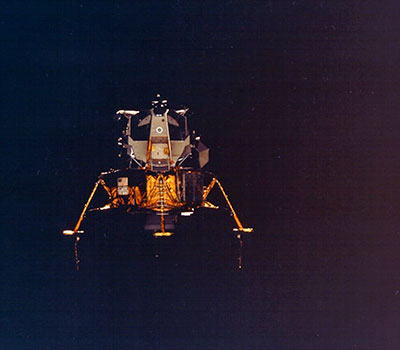 |
sev8n
Member Posts: 265
From: Dallas TX USA
Registered: Jul 2012
|
 posted 08-05-2012 05:55 PM
posted 08-05-2012 05:55 PM
  
quote:
Originally posted by ilbasso:
So, the Service Module did the work of lowering the orbit significantly before the Descent Engine had to be used. That saved a lot of fuel.
Orbital mechanics is not my specialty, but I assume this was achieved with a highly elliptical orbit with a 10 mile perigee. If so, wouldn't the velocity of the C/S/LM be much greater at the 10 mile perigee vs a 60 mile circular orbit? Would it not take roughly the same amount of fuel to slow the LM at the perigee (more kinetic energy) as it would to descend from a circular 60 mile orbit (more potential energy)? Or is my assumption of an elliptical orbit incorrect? |
ilbasso
Member Posts: 1527
From: Greensboro, NC USA
Registered: Feb 2006
|
 posted 08-05-2012 06:50 PM
posted 08-05-2012 06:50 PM
   
Correct, it was an elliptical orbit with the pericynthion above the landing site.Once PDI was initiated and the LM was on the way down, I believe, the CSM circularized its orbit at 60 nm to begin its mapping and SIM Bay measurements. |
ilbasso
Member Posts: 1527
From: Greensboro, NC USA
Registered: Feb 2006
|
 posted 08-06-2012 04:08 PM
posted 08-06-2012 04:08 PM
   
Another great photo, during fit check, of the LRV installed on the side of Apollo 15's LM.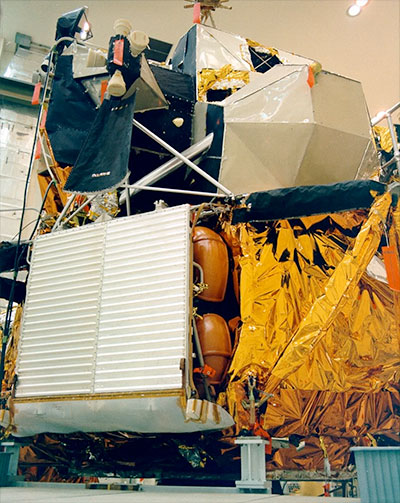 |
LM-12
Member Posts: 3895
From: Ontario, Canada
Registered: Oct 2010
|
 posted 08-13-2012 05:09 PM
posted 08-13-2012 05:09 PM
  
Here is a similar shot of the Apollo 17 LM in lunar orbit.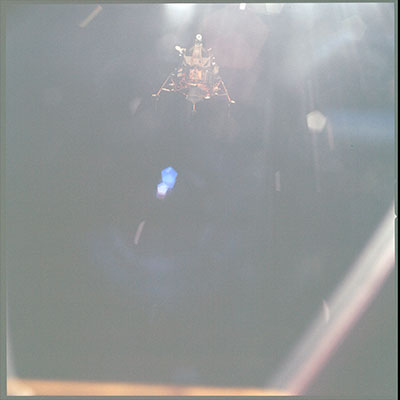 |
moonguyron
Member Posts: 191
From: Trinity, FL USA
Registered: Jan 2011
|
 posted 03-06-2017 04:30 PM
posted 03-06-2017 04:30 PM
   
For Apollo "J" missions that included a lunar rover, after the lunar module was buttoned up for flight was any of the rover's bottom chassis visible? Or was Kapton or other insulation used to cover the entire quadrant that was removed by the astronauts as the first step in the rover's deployment? I have seen pictures of both. Any help would be appreciated. Editor's note: Threads merged. |
NJ CO
Member Posts: 23
From: Greenwich, NJ, US
Registered: Mar 2008
|
 posted 03-11-2017 09:59 AM
posted 03-11-2017 09:59 AM
  
quote:
Originally posted by Jay Chladek:
The Science Channel "Moon Machines" documentary series gives a good account of the LRV design and integration in its final episode.
Was just going to add that the Science Channel series mentioned already was very interesting. If you can find it, it's well worth it. |


















